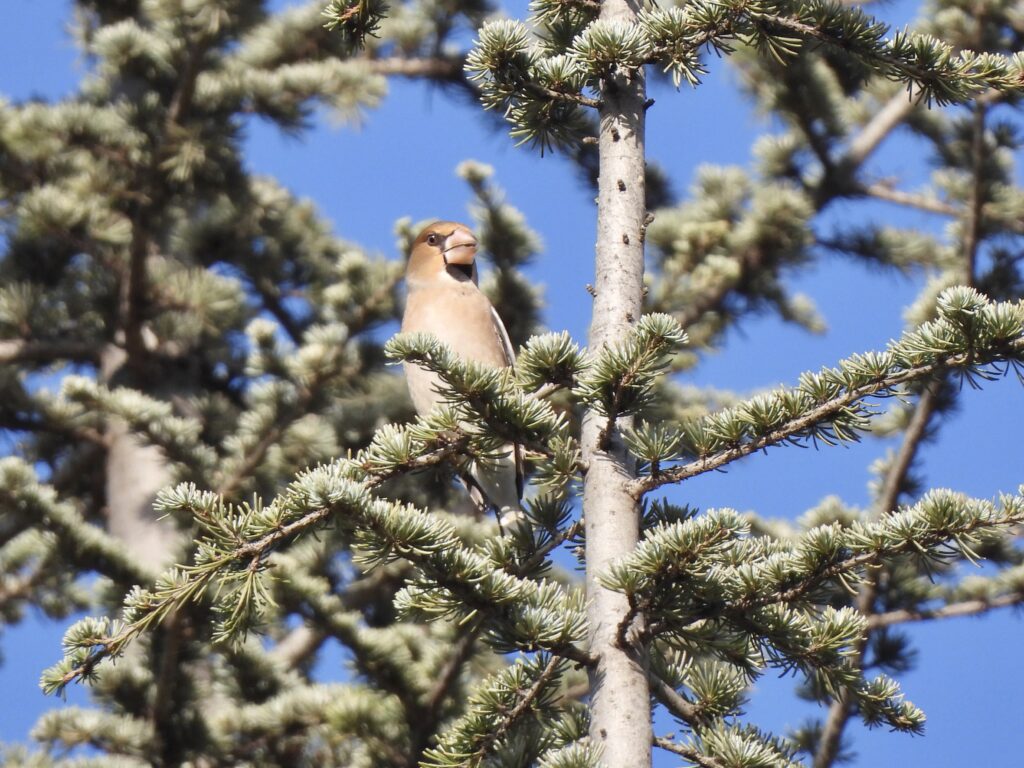Strolling in El Romeral park in Alcoi feels like stepping back in time. As my family lives next door and the park surrounds my former primary school, I had explored countless times as a child, the place where I first discovered many bird species, sparking the joy of birdwatching. I do not visit it as often anymore, mostly because recent renovation work resulted in the loss of some good areas for birds — e.g., rock buntings (Emberiza cia) in an orchard area nearby, and some forest specialists after a grove with old Aleppo pines (Pinus halepensis) was cut off. While I usually think of what it used to be, El Romeral does not defraud still today.

My main motivation was to locate and photograph firecrests (Regulus ignicapilla). While a big chunk of the park is covered in deciduous garden trees — maples, planes, poplars… — the presence of cedars and firs is favored by these little birds. The population of the species in the park has been present since I was a kid.

This morning has been sunny and quite warm for late November, and many trees still keep most of their foliage. European collared-doves (Streptopelia decaocto) and greenfinches (Chloris chloris) sat on tree tops. Different blackcaps (Sylvia atricapilla) called from every single olive tree of the park. About a dozen chiffchaffs (Phylloscopus collybita) gathered in an English oak (Quercus robur) looking for insects to feed on.

A sudden commotion drew my attention to a black redstart (Phoenicurus ochruros) behaving oddly. As I approached it, I noticed it struggled to fly. I soon realized it was being chased off by a territorial robin (Erithacus rubecula), which are surprisingly aggressive when it comes to defending their space.

I could pick out the high-pitched calls of firecrests. Their song — a rapid series of notes — pierced the air in different directions, guiding me to the treetops where these feathered gems darted from branch to branch. I have noticed at least seven territorial males.

As the males sang to defend their territory, they displayed a fiery orange crest bordered by black, complemented by a bright white stripe running above their eye. The bold coloration — fire! — and the attitude compensate for his diminutive stature.

Firecrests are among the smallest birds in Europe, measuring just 9 cm in length and weighing less than 6 grams. Despite their tiny size, they are full of energy and personality, flitting restlessly among branches and singing loudly. These characteristics make them fascinating to observe, though photographing them is no small challenge.

I watched as a male I was photographing engaged in a brief chase with a rival coming to its territory. The two darted through the canopy in a blur of wings and fiery crests, their movements almost too fast to follow. As soon as the battle was finished, two females showed up and followed the flamboyant champion.

The spot where I saw the most firecrests was an open lawn area with immature plane trees (Platanus x hispanica) and a hedge of tall cypresses (Cupressus sempervirens). This spot was also favored by several short-toed treecreepers (Certhia brachydactyla), also busy with their songs and territories. Blackbirds (Turdus merula) and magpies (Pica pica) were not far away.

Other forest birds eventually showed up. A long-tailed tit (Aegithalos caudatus) foraged while calling, probably looking for its family group as it was unusually alone. A couple of mixed-species flocks bore crested tits (Lophophanes cristatus), coal tits (Periparus ater), and great tits (Parus major).

While I was photographing these species, a familiar silhouette flew on top of a distant cedar. The shape, wing pattern, and even only the size of the hawfinch (Coccothraustes coccothraustes) in flight are unmistakable. I detected a female on top of an Atlas cedar (Cedrus atlantica) which flew away almost as soon as I photographed it. El Romeral was the place where I lifered this species in Dec 2019, and I have seen few birds in some of the subsequent winters. This species is always the star of the show, as its quiet behavior and irregular phenology make every sight memorable. This is my first personal record this season, in this urban park that has become a reliable hawfinch spot of mine, luckily just next door.

Before leaving, I walked by a blue Atlas cedar, the very tree where I spotted my first-ever firecrest back when I was 8 or 9. Most firecrests in the morning provided distant looks, but this is not a particularly skulking species. In fact, a showy male appeared at very close range for a second.

As I reviewed the images, a sense of gratitude washed over me. Firecrests had been part of the spark of my admiration for birds as a kid, and today, they reminded me why that fascination has endured. A reminder of how a simple childhood curiosity can build up and evolve into a whole career.




